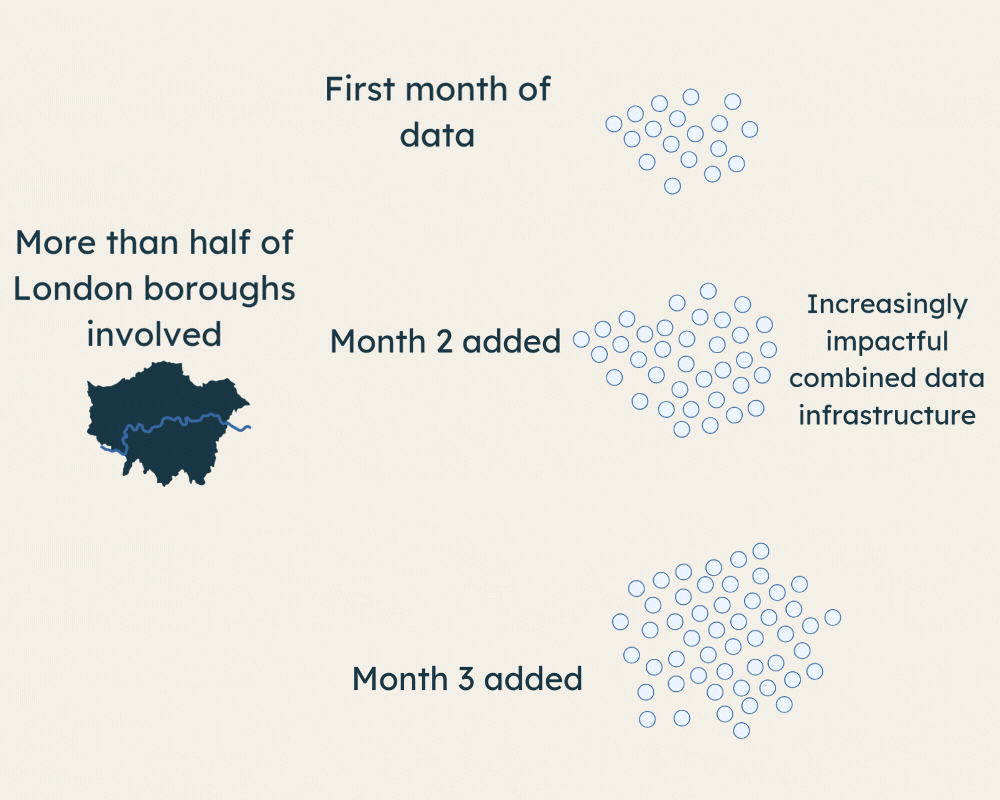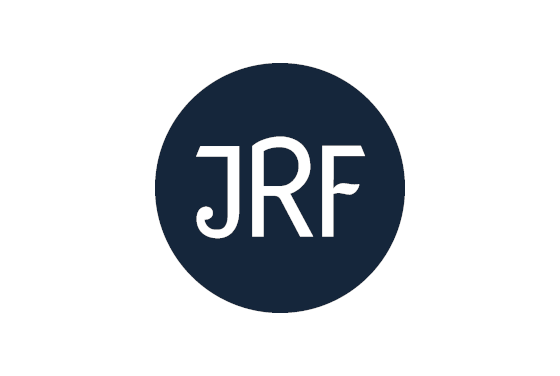How we measure poverty and low income matters. And real-time data is important for policy. However, when it comes to UK households’ living standards, no reliable real-time data is available.
The Family Resources Survey (FRS), the source for official measures of poverty across the UK, is released with a one year delay. The latest FRS results, released in March 2024, cover the period up to March 2023. We therefore do not know how many households are currently living in poverty, how far below the poverty line they are, and how effective different social policies might be in alleviating poverty.
Policy in Practice, backed by the Joseph Rowntree Foundation, has developed R.A.P.I.D. - a new tool to track more up-to-date aggregate rates of low income and poverty. It uses administrative data collected routinely by local authorities as part of the benefits award process to give a more real-time picture of poverty and low living standards in the capital.


To find out more about this collaboration between the JRF Insight Infrastructure project and the team at Policy in Practice you can contact us here.
All of the measures in R.A.P.I.D. are worked out at the household level and are calculated before housing costs are included, as we do not have reliable information on housing costs for all households in the dataset.
This project uses data from households in receipt of benefits only. This will have an impact on our results, as we might expect benefits recipients to be more likely to experience lower standards of living and higher rates of poverty than the population as a whole. The data used for R.A.P.I.D covers approximately 21% of the overall population of the boroughs participating in the project.
R.A.P.I.D. currently shows aggregate measures of poverty and low income across more than half of London boroughs, starting in September 2023. These boroughs are all Policy in Practice clients, and represent a mix of inner and outer London boroughs. Due to technical and other constraints, it is not possible currently to break down R.A.P.I.D. by borough.
It has been updated monthly until September 2024 to test the impact of having more up to date information on low income with a more immediate view of trends across the capital. Another quarterly refresh covering October, November, and December 2024 was carried out in early 2025. Extension of the data to cover regions beyond London is a possibility for the future and we would welcome your feedback on the site, your use of the data presented here, and what real time data you would like to see in the future.
The four measures of poverty and living standards that we calculate and display are:
All of our measures are equivalised, meaning we take into account the fact that different household types - single people, couples with young children, lone parents and so on - need different levels of income and resources to get by.
The section below gives the headline data for the four key measures by month, set to the latest month by default. Full information on how the data was processed is available in the 'About Project' section.
You can click the green button for each area to get further detail on trends; household groups most impacted; and a breakdown of the levels of poverty.
Select timepoint:
The next headline chart focuses on the recent monthly trends. You can choose the measure and optionally group by household groups to see the trend by group.
R.A.P.I.D. is a project which estimates poverty rates in London via the innovative use of the administrative data generated by local authorities as part of the benefits award process. Administrative data is created any time people interact with public services. The data generated by local authorities in the course of their administration of benefits is collected and processed at frequent regular intervals, unlike surveys such as the FRS, which runs continuously but is released with a long lag due to the time taken to process the data.
The administrative data we have used in this project is recent, accurate, and detailed. Local authorities need this data to distribute benefits, but the details in the datasets also allow us to estimate poverty rates and living standards in real time. While the most recent official poverty data using the FRS results was published in March 2024 and covered the period March 2022 - March 2023, our metrics are calculated more frequently, starting in September 2023 and continuing to update until December 2024, providing as close to ‘real time’ data as we can.
The data in R.A.P.I.D. comes from a range of London Boroughs, who are all existing clients of Policy in Practice. We are unable to provide borough-level data or filtering as part of this project at this time.
This project makes use of the public sector administrative data created to process and administer benefits such as Universal Credit, Council Tax Support, and Housing Benefit. This data contains information such as income levels, and household occupancy necessary for benefits processing.
R.A.P.I.D aggregates benefits administration data for more than half of all London boroughs, using data such as household income to measure and map poverty rates. Powered by Policy in Practice’s policy engine, we have applied poverty metrics and living standards data to measure poverty rates with only a month’s delay compared to a year or more's delay for the Family Resources Survey and other poverty metrics.

This data was analysed by the team at Policy in Practice who support local councils nationally to better use this data to assist residents. The London boroughs in R.A.P.I.D. are all existing Policy in Practice clients.
As a first step, four key indicators were created to match national statistics: absolute income poverty, relative income poverty, a resource-focused view of poverty, and the Minimum Income Standard. These are explained in greater detail below.

Due to the data source the project currently only looks at households in receipt of benefits, not the whole population of the borough.
These are often the households most likely to need support and who are most impacted - negatively or positively - by changes to local and national policy.

Focusing on this group of households claiming benefits also allows a wider context to be assessed. A key dimension of the research is providing estimates split by various different household circumstances. The kinds of information gathered as part of the benefits award process, such as tenure type or household composition, means that R.A.P.I.D.'s results can be broken down by different demographic and socio-economic factors.
No household is the same - so this information will help identify particularly vulnerable groups and design tailored programmes. When breaking down by circumstance, we must always keep in mind that we are looking at a slice of a subset of the whole population.

The data produced for this project is only 1 to 2 months old at the time of publication. This allows a much quicker sense of trends in poverty measures and living standards.
This is particularly useful when also looking at household groups. The chart below can be changed to any of the four key measures used in the study. It gives the percentage point change in the poverty rate for all low-income households, and for each household type. The underlying rate for the previous month is also given for an at-a-glance insight into most recent fluctuations in poverty rates and living standards, with data going back to September 2023 available for emerging trends.
R.A.P.I.D. data has allowed for new variations on key measures to be created. Rather than thinking in terms of a binary 'in poverty'/'not in poverty' split, we can break down each category to gain a fuller picture of how households are faring. Not all those classified as 'in poverty' are in the same position, and the same goes for those who are 'not in poverty'.
For households classified as 'in poverty', we can distinguish between those in 'deep poverty' and those in 'moderate poverty'. Households with less than 40% of the income threshold considered to be in poverty can be thought of as being in 'deep poverty', while households with a level of income between 40% and 100% of the poverty threshold are in 'moderate poverty'.
Similarly for those who are 'not in poverty', we can define a section that is 'at risk of poverty', with income of somewhere between 100% and 120% of the poverty threshold. These are households who are not below the threshold but are very close to it and may require a different form of support to those in 'moderate' or 'deep' poverty.
Insights like this are made more actionable by breaking the data down across household types. The chart below gives the overall poverty rate for any of the individual measures for all the different household groups.
Building on the shift away from binary thinking on households as being either 'in poverty' or 'not in poverty', R.A.P.I.D. can provide further insight on the circumstances of low-income households by showing the average monthly shortfall experienced by households for each of our measures.
Assessing how much money low-income households would need to no longer be categorised as 'in poverty' provides a different perspective on poverty in London, and helps us to think about the scale of change needed to lift households out of poverty, by any metric. Results reveal that most households below the poverty line under any measure would require a significant increase in income to change their circumstances.
R.A.P.I.D. provides the average monthly shortfall to the income threshold for all of the poverty and low-income measures. As with the analysis above, it is split by household type.
Blog #3: Income or Resources. Developing our metrics
A key distinction is between metrics focused solely on household income and those that consider household resources...
Read MoreBlog #2: Metrics, metrics and more metrics
Poverty is complex and there is little consensus on how to best measure it in the UK or further afield...
Read MoreBlog #1: What’s so rapid about R.A.P.I.D.?
Data and insight into poverty metrics and living standards in the UK are out of date on the day they are published...
Read MoreWe know that discussions around poverty and poverty measurement can involve plenty of new words and acronyms. Here is a list of some of the most important terms we use when talking about low income and the R.A.P.I.D. project, and their explanations.
Deep poverty: A household is in deep poverty if it has less than 40% of the income threshold. What exact threshold that is depends on what poverty measure you are interested in. For instance, if you were interested in absolute poverty, then a household with less than 40% of the absolute poverty threshold is classified as being in deep poverty. It contrasts with moderate poverty (see below).
Family Resources Survey (FRS): The FRS is a continuous household survey that collects information on a representative sample of private households in the UK. The Department of Work and Pensions uses FRS data to understand UK households' incomes and living circumstances. It publishes annual reports for each financial year (March of one year to March of the following year), usually with at least a one year delay between the latest data collection and publication. This delay is due to the processing and quality assurance of the survey data.
Households Below Average Income (HBAI): This is the official source of figures on the number of people in low income in the UK. Published annually by the Department of Work and Pensions, the HBAI is based largely on the results of the Family Resources Survey. It is generally published with a one-year lag due to the preparations needed to ensure the accuracy of the FRS data.
Joseph Rowntree Foundation (JRF): An independent social change foundation and charity working to end poverty in the UK. One of the two organisations behind R.A.P.I.D., alongside Policy in Practice.
Minimum Income Standard (MIS): A set of budgets for different household types that cover what each would need to spend to reach an acceptable standard of living, as determined by members of the public. Developed by the JRF and Loughborough University.
Moderate Poverty: Households in moderate poverty have an income level that is between 40% and 100% of the income threshold for whatever poverty metric you are interested in. It can be contrasted to deep poverty (explained above)
Policy in Practice: A social policy analytics and software firm interested in innovative ways to use public sector data to improve lives and drive change.
Social Metrics Commission (SMC): An independent non-governmental organisation focussed on developing a new approach to poverty measurement. It has proposed a new metric for measuring low income based on household (in)ability to access average resources.
R.A.P.I.D. is an ongoing project, and we would welcome any feedback you may have on the tool and the data it contains. We would especially love to know any ideas you may have for how you could use the dashboard in your organisation. We have a feedback form for general comments, questions, suggestions for improvement, and potential use cases available here.
Give feedback on R.A.P.I.D.Poverty and low income are complex topics. Here are some of the resources we found most useful when thinking about poverty measurement and the development of R.A.P.I.D.
Many thanks to the boroughs who supported this study by providing data, and all colleagues who have provided feedback on the project.


